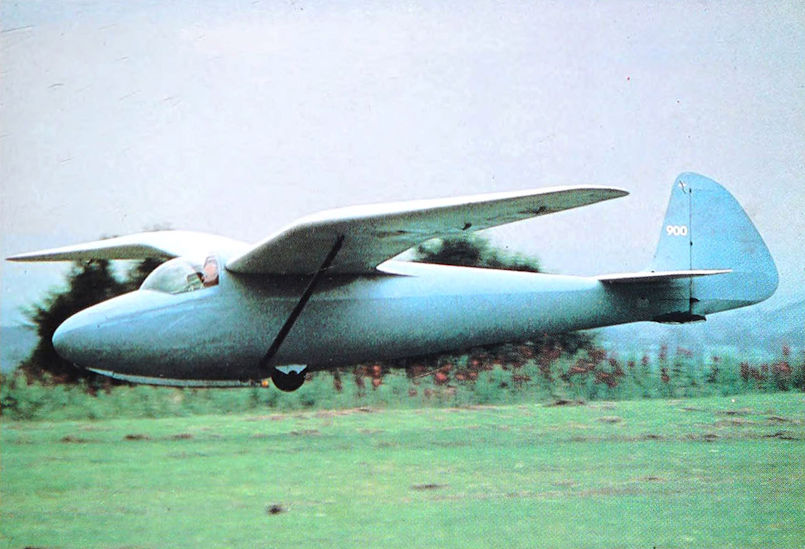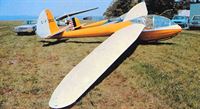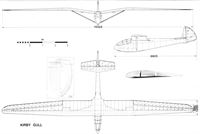
Варианты
- Schneider - Grunau Baby - 1931 - Германия
- Dart - Cambridge - 1935 - Великобритания
- Goppingen - Go.1 Wolf - 1935 - Германия
- Slingsby - T.6/T.23 Kirby Kite - 1935 - Великобритания
- Slingsby - T.7 Kirby Cadet / T.8 Kirby Tutor / T.20 / T.31 - 1936 - Великобритания
- Slingsby - T.12 / T.14 / T.15 Gull - 1938 - Великобритания
- Slingsby - T.21 Sedbergh / T.30 Prefect - 1944 - Великобритания
- Slingsby - T.29 Motor-Tutor - 1947 - Великобритания
M.Simons The World's Vintage Sailplanes 1908-45
THE KIRBY GULL
Fred Slingsby began work on the Kirby Gull in the later months of 1937. The prototype flew in April 1938 and proved quite successful.
It had a streamlined fuselage with a fully contoured cockpit canopy. For the inexperienced pilot, forward visibility was badly restricted by the wooden hoops of the framework. In addition, the transparent plastics used in small panels tended to distort the view. Slingsby fitted a window which could be opened in the front section of the canopy, so that for landing the pilot could see directly forward.
The wing root junction to the fuselage was carefully worked out. The fairing over the centre section was a built-up plywood shell, detachable for rigging and de-rigging. The wing had the fashionable ‘gull’ dihedral which was attractive to look at even though it did nothing for aerodynamic efficiency. Slingsby chose the NACA 4416 aerofoil for the main part of the wing, tapering to RAF 34 at the tip. Wing bracing struts saved a good deal of weight and Slingsby still felt it wise to keep the wing loading down. Spoilers were not fitted on the first production aircraft but were added later to all Gulls.
The sailplane handled well and became popular. Four Gulls were entered in the National Competitions in July 1938. At this contest a prize was offered for the first sailplane to soar across the English Channel. Several pilots did reach the south coast but had insufficient height to risk gliding across to France.
The next year, on 22nd April, Geoffrey Stephenson arrived late for a flight from Dunstable, taking off in the light blue painted Gull in which he had a third share, by winch launch at 2.55 pm. He quickly thermalled up to cloud base and set off downwind toward the Thames Estuary east of London. When he saw the coast to the south he realised this might be his opportunity. He reached Hawkinge aerodrome, not far from the sea, at 300 metres, found a good thermal, and circled up into cloud and continued the climb to nearly 2000 metres. When he straightened up and emerged he was already over water and set off toward the distant coastline. There was no lift over the sea but after an anxious time he crossed the French coast at about 800 metres and had enough height left to glide on 16 kilometres inland to touch down at 5.35 pm. His distance from Dunstable was just over 200 km. The flight had taken 2 hours 40 minutes.
In Australia a Gull was imported in 1939. It was flown by Martin Warner and Stephen Newbigin at the Australian National Rally at Geelong in the last week of December that year. In it Norman Hyde set the Australian National altitude record at 1615 m and in January 1940 Newbigin raised this to 2407 m at Camden, NSW. At Easter in 1940 the Gull was taken to Narromine. The idea was to tour New South Wales by glider. The Gull, launched as soon as soaring became possible each morning, flew across country as far as the pilot could manage. The DH Moth and the ground crew would follow, to launch another pilot the next day, and so on. These flights were the first indication of the enormous potential of Australian inland soaring conditions. After the war, there were other successful tours. A particularly notable flight was that by Harry Ryan on Boxing Day, 1945, when after being launched at Jerilderie, he flew more than 300 km to Melbourne, floating over the city itself before surprising the air traffic controllers at the main airport, Essendon, by landing in front of the control tower.
The Australian Gull was fitted, during these tours, with radio, the unit was crystal controlled and worked on 350 kHz, with an effective range, air to ground, of more than 300 km.
One Gull survives in regular use in England. This aircraft is unlike the original in that it has a wheel undercarriage and the cockpit canopy has been rebuilt with a bubble-type transparent hood instead of the fully contoured type.
Slingsby improved on the Gull 1 when he redesigned the wing and made it fully cantilever. The Gull 3 had a performance comparable to that of the Olympia and may have been better at high speeds because of its less cambered aerofoil. The Gull 3 also was still extant in 1980.
In America, working from plans provided by Slingsby, Herman Kursawe built a Gull 1, and this too remained serviceable and appeared at vintage glider meetings in the USA in the late seventies. All told, including the cantilever Gull 3 and the American one, eleven Gulls were built.
The Gull 2 was a large two-seat sailplane designed just prior to the outbreak of war in 1939, and it was finished to make its first flight in 1940. It was flown extensively after the war and set several national records. It was written off after a crash in 1952.
Technical data:
Gull 1: Span, 15.33 m. Wing area, 14.86 sq m. Aspect ratio. 15.81. Empty weight, 172.5 kg. Flying weight, 283.5 kg. Wing loading, 19.1 kg/sq m. Aerofoils, root and centre section, NACA 4416. tapering to RAF34 at the tip.
- M.Simons The World's Vintage Sailplanes 1908-45
Фотографии
-
GL / M.Simons - The World's Vintage Sailplanes 1908-45 /Kookaburra/
The only Kirby Gull I still flying in its country of origin. It has a modified cockpit canopy to give a better view forward from the cockpit, and a landing wheel. The slender steel tube struts replace the earlier ones which were of large cross-section. This Gull has made many excellent cross-country flights in recent years.
-
Aeroplane Monthly 1986-10 / Slingsby Type 15 Gull III /Preservation Profile/
The photographs were taken near High Wycombe on July 23, 1986. Owner Mike Beach can be seen at the controls.
-
GL / M.Simons - The World's Vintage Sailplanes 1908-45 /Kookaburra/
Регистрационный номер: N41829 [3] One of the only two remaining airworthy Kirby Gull Is, this example was built from Slingsby plans by Herman Kursawe in New York. It is currently owned by Tom Smith. Except for the moulded cockpit canopy and the slender steel struts, it is exactly like the factory-built aircraft. Note the centre section root fairing, which is lying on the ground near the nose. This detachable panel, of complex shape, was built up from plywood.
-
GL / M.Simons - The World's Vintage Sailplanes 1908-45 /Kookaburra/
Taken at High Wycombe in 1971, this photograph shows, left to right, the nose of a Weihe, the Cantilever Gull or Kirby Gull 3, the Dunstable-based Minimoa and at the far end of the line, the Kirby Tutor.
Другие самолёты на фотографии: DFS Weihe - Германия - 1938Goppingen Go.3 Minimoa - Германия - 1935Slingsby T.7 Kirby Cadet / T.8 Kirby Tutor / T.20 / T.31 - Великобритания - 1936
-
Aeroplane Monthly 1996-07 / 1996 UK Aircraft Collections and Museums Guide (1)
A special exhibition of Mike Beach’s glider collection (plus his Bleriot XI at top left) at the Brooklands Museum in 1993. From bottom of picture: Slingsby Falcon I replica, Slingsby Gull 3, Schleicher Rheinland, Manuel Willow Wren, Abbott-Baynes Scud II, Hols der Teufel replica. All but the Rheinland are still at Brooklands, although space limitations dictate that they spend much of their time stored in their trailers. The hangar in this view has since been demolished.
Другие самолёты на фотографии: Abbott-Baynes Scud - Великобритания - 1931Bleriot Bleriot-XI - Франция - 1909FVA (Flugwissenschaftliche Vereinigung Aachen) FVA-10 Rheinland - Германия - 1936Lippisch / RRG Falke - Германия - 1930Lippisch / RRG Hols der Teufel - Германия - 1923Manuel Wren - Великобритания - 1931
-
Aeroplane Monthly 1993-06 / M.Oakey - Grapevine
A line-up of rarities at Brooklands. From the foreground: Slingsby Falcon I replica; Slingsby Gull III; Schleicher Rheinland; Manuel Willow Wren BGA 162; Abbott-Baynes Scud II; Hols der Teufel replica; Bleriot XI G-LOTI.
Другие самолёты на фотографии: Abbott-Baynes Scud - Великобритания - 1931Bleriot Bleriot-XI - Франция - 1909FVA (Flugwissenschaftliche Vereinigung Aachen) FVA-10 Rheinland - Германия - 1936Lippisch / RRG Falke - Германия - 1930Lippisch / RRG Hols der Teufel - Германия - 1923Manuel Wren - Великобритания - 1931
-
GL / M.Simons - The World's Vintage Sailplanes 1908-45 /Kookaburra/
A restored Pratt Read G-I or LNE-1, carrying a Canadian registration. The TG-2 and Kirby Gull 1 are visible in the background.
Другие самолёты на фотографии: Pratt-Read LNE-1 / TG-32 - США - 1942Schweizer SGS 2-8 / TG-2 - США - 1938
-
Aeroplane Monthly 1993-07 / M.Simons - Sling's sailplanes (10)
Регистрационный номер: BGA348 The Derbyshire and Lancashire Gliding Club’s Kirby Gull, BGA 348, flying at the 1938 National Gliding Competitions at Dunstable. This was the second Gull built; no spoilers were fitted at the time.
-
Aeroplane Monthly 1993-07 / M.Simons - Sling's sailplanes (10)
The prototype Gull flying at Gawler, the base of the Adelaide Soaring Club in South Australia, in 1957.
-
Flight 1939-04 / Flight
A Kirby Gull - built by Slingsby Sailplanes - of the type in which Mr. J. H. Stephenson reached France from a winch-launch at Dunstable.
-
Aeroplane Monthly 1993-07 / M.Simons - Sling's sailplanes (10)
Grace: A fine aerial impression of a typical high-performance sailplane, Mr. Hiscox's Kirby Gull. The photograph was taken from a two-seater glider.
A fine Charles E. Brown study of a Slingsby Gull over Dunstable in July 1938, during practice for that year’s National Gliding Competitions. -
Aeroplane Monthly 1993-07 / M.Simons - Sling's sailplanes (10)
The modified prototype Gull soon after its arrival in Australia in 1939. The canopy and spoilers were brought up to the new standard before export.
-
GL / M.Simons - The World's Vintage Sailplanes 1908-45 /Kookaburra/
The Kirby Gull in Australia, with one of its most successful pilots, Harry Ryan, on a superb soaring day at Box Hill, NSW, in 1939. The Australian Gull was painted pale blue, as was the Cross-Channel Gull, with clear doped fabric. In the sunny conditions of NSW, complete re-covering was essential every two or three years. The canopy was made of separate small panels, each carefully moulded to conform to the nearly perfect aerodynamic contour, and set in a complex frame of laminated wooden hoops.
-
GL / M.Simons - The World's Vintage Sailplanes 1908-45 /Kookaburra/
Регистрационный номер: G-ALPJ The Gull with the unpopular post-war registration letters painted onto the clear varnish factory finish. This was the only Gull 1 fitted with a wheel. The rudder stripes were dark blue and white, a Derbyshire and Lancashire Gliding Club marking.
BGA 378, with wheel, at the Derby & Lancs site at Camphill in 1949. It wears the club’s blue-and-white stripes on its rudder, as well as registration letters. Otherwise the finish was clear dope and varnish. This Gull, with a modified canopy, still flies regularly. -
Aeroplane Monthly 1988-11 / Personal album. Civil
Регистрационный номер: G-ALLC [2] Snapped at Dunstable in June 1949 is the very pretty Slingsby Type 12 Gull 1 G-ALLC/ BGA380. Owned by the resident London Gliding Club and painted pale blue overall with dark blue lettering, ’LC was first certificated in December 1938 and was still extant in the early Fifties. The first prototype Gull 1 was first flown in April 1938.
-
Aeroplane Monthly 1993-07 / M.Simons - Sling's sailplanes (10)
Регистрационный номер: G-ALLC [2] The Cross-Channel Gull, BGA 380, also at Camphill in 1949. The tailplane has not yet been rigged.
-
Aeroplane Monthly 1993-07 / M.Simons - Sling's sailplanes (10)
Регистрационный номер: N41829 [3] The American Gull, N41829, built from plans by Herman Kursawe in 1942. This example still survives.
-
GL / M.Simons - The World's Vintage Sailplanes 1908-45 /Kookaburra/
Регистрационный номер: N41829 [3] The American Gull still flying in 1980.
-
Aeroplane Monthly 1993-12 / M.Simons - Sling's sailplanes (12)
The Gull 2 in flight near Lasham in 1957. It was by far the largest and most complex pre war aircraft Slingsby had undertaken.
-
Aeroplane Monthly 1993-12 / M.Simons - Sling's sailplanes (12)
The Gull 2 during an aero-tow in 1957, before competing in the National Championships. Note the enlarged fin and the addition of a small castoring wheel. The tow-release is on the belly of the sailplane.
-
Aeroplane Monthly 1993-12 / M.Simons - Sling's sailplanes (12)
The Gull 2 fuselage outside the workshop, showing a wing root template clipped temporarily in place.
-
Aeroplane Monthly 1993-12 / M.Simons - Sling's sailplanes (12)
The Gull 2 nearing completion. Fred Slingsby, right, and an unknown assistant check the controls. Note the butterfly-type canopy. In the background the A-frame and wings of a Slingsby Primary glider bear the old golden eagle trademark.
Другие самолёты на фотографии: Slingsby T.3 Dagling - Великобритания - 1930
-
Aeroplane Monthly 1985-06 / Grapevine
Mike Beach has recently acquired the Slingsby Gull 3 prototype, the fuselage of which is seen here being unloaded at Brooklands on March 23, 1985.
-
Aeroplane Monthly 1985-09 / Grapevine
Mike Beach's Slingsby Gull 3 at Brooklands on June 8, 1985.
-
Aeroplane Monthly 1986-10 / Slingsby Type 15 Gull III /Preservation Profile/
Three photographs of the Gull III taken at Heston in 1945 by Barry Gould. Note the RAF roundels arid stripes and the name Kittiwake painted beneath the cockpit canopy.
-
Aeroplane Monthly 1993-07 / M.Simons - Sling's sailplanes (10)
Slingsby Type 12 Gull
-
Aeroplane Monthly 1993-12 / M.Simons - Sling's sailplanes (12)
Slingsby Type 14 Gull 2
- Фотографии



























